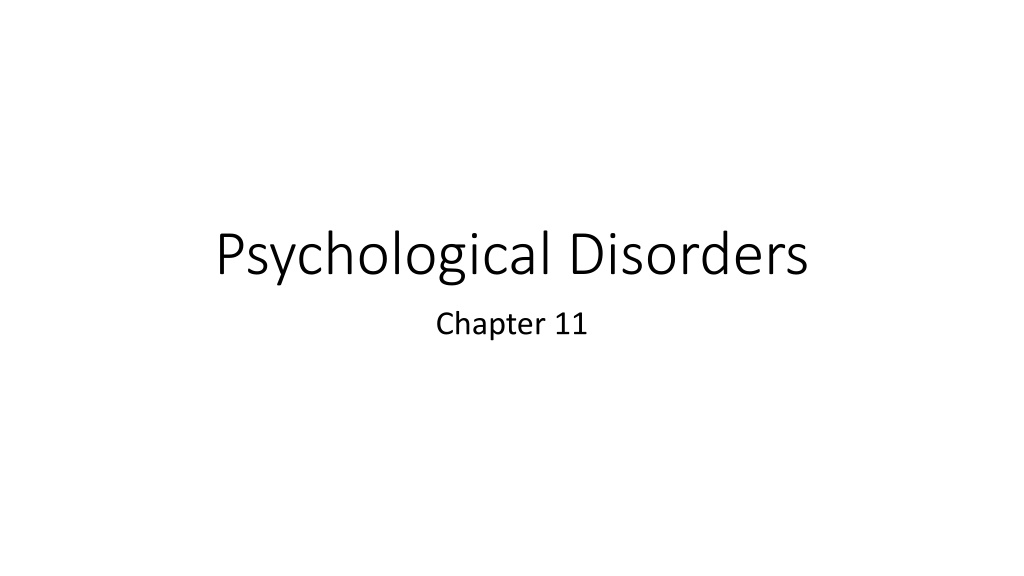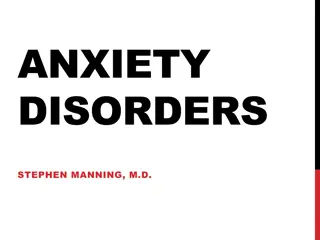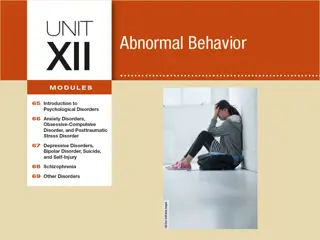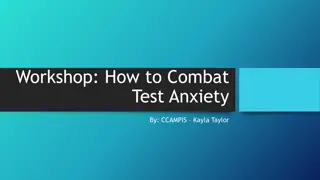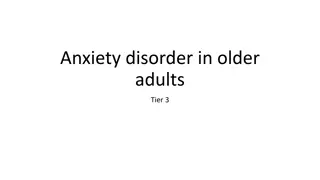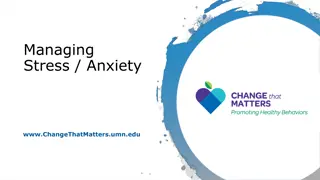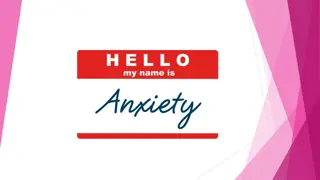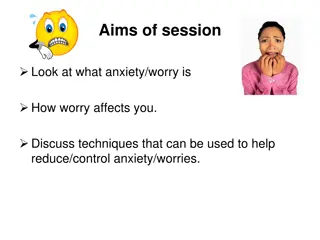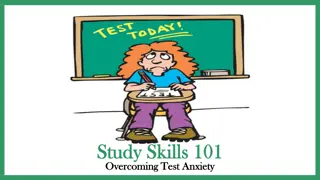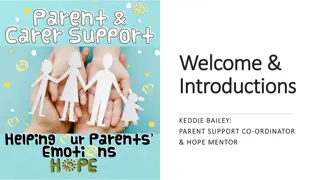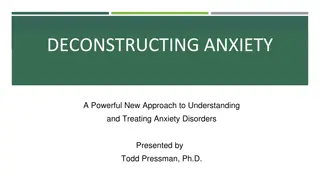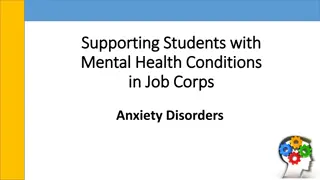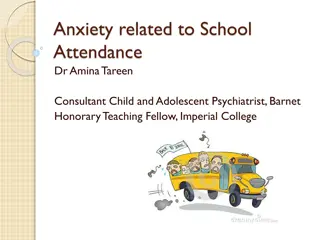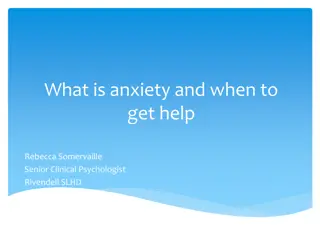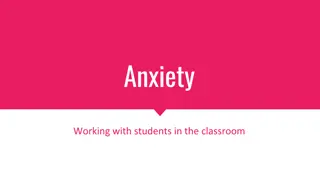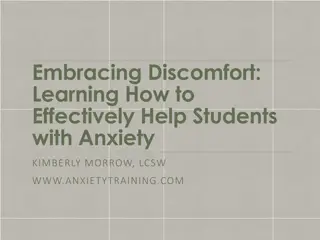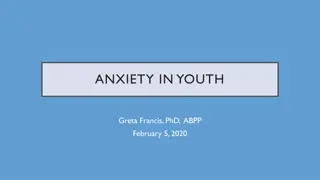Overview of Anxiety and Related Disorders
Anxiety disorders, such as PTSD, panic disorders, phobias, agoraphobia, and OCD, are characterized by varying degrees of fear and distress. Anxiety is a normal response to danger, but when it becomes chronic, it can lead to debilitating conditions. PTSD occurs post-trauma, panic disorders involve intense attacks of fear, phobias are adaptive fears that may be acquired through experiences, agoraphobia leads to a fear of public spaces, and OCD entails unwanted thoughts and compulsive behaviors. Understanding these disorders is crucial for effective management and support.
Download Presentation

Please find below an Image/Link to download the presentation.
The content on the website is provided AS IS for your information and personal use only. It may not be sold, licensed, or shared on other websites without obtaining consent from the author.If you encounter any issues during the download, it is possible that the publisher has removed the file from their server.
You are allowed to download the files provided on this website for personal or commercial use, subject to the condition that they are used lawfully. All files are the property of their respective owners.
The content on the website is provided AS IS for your information and personal use only. It may not be sold, licensed, or shared on other websites without obtaining consent from the author.
E N D
Presentation Transcript
Psychological Disorders Chapter 11
Anxiety Disorders Section 1
What is Anxiety? A general state of apprehension or uneasiness It is normal to feel this way in a dangerous situation Ex. You see a Pit bull walking towards you not on a leash It is CHRONIC (and not normal) when the feeling is long lasting and when not in actual danger
Posttraumatic Stress Disorder (PTSD) Occurs in the aftermath of serious TRAUMA (war, torture, natural disasters) Symptoms are: insomnia, depression and intrusive thoughts Most people eventually recover (92% of men / 80% of women) Some may last for years or even decades
Panic Disorders Recurring attacks of INTENSE panic with feelings of impending doom or death Last from a few minutes to hours Symptoms are: Dizziness, rapid heartbeat, chest pain, hot and cold flashes Usually occur in the aftermath of trauma (days or weeks)
Phobias (Fears) Common Evolved for ADAPTIVE advantages Conditioning Acquired through personal experiences Heights ( acrophobia) Color purple Ex. Humans can t climb well so we shouldn t be in high spaces Number 13 Enclosed spaces (claustrophobia) Hive shaped things
Agoraphobia The most DISABLING of all fear disorders Fear of being trapped in a public space (theatre, mall, bridge) Starts as occasional panic attacks Eventually people are afraid to leave their homes Fear or fear itself rather than fear of places
Obsessive Compulsive Disorder Obsession = unwished thoughts or images Compulsion = repetitive behaviors that MUST be carried out in order to avoid disaster Different from SUPERSTITION Ex. A baseball player might not wash jersey until they have a bad game
OCD cont. People with OCD can t turn off the brains alarm signal for FEAR Sufferer feels in a constant state of danger Ex. One person must run up and down each flight of steps they see 65 times in 45 minutes Another person must turn a light switch on and off 7x upon entering a room
Section 1 Review: 1. Describe how PTSD occurs and some symptoms of it. 2. Compare COMMON to CONDITIONED phobias. 3. What is considered the most DISABLING of all disorders? Why? 4. Give an example of a SUPERSTITON and an OC ritual.
Mood Disorders Section 2
Mood Disorders Moods range from extreme DEPRESSION to extreme MANIA Everyone feels emotions from sadness to joy Everyone feels wild anger, grief and happiness at extreme moments in their lives Mood disorders are very different from NORMAL feelings
Major Depression Belief that NOTHING good will ever happen Loss of interest in usual PLEASURABLE activities Exaggeration of MINOR failing (failed quiz; I might as well drop out of school) Think of losses as a sign of personal failure
Cont. Physical changes occur such as; loss of appetite, insomnia, and headaches Occurs 2x as much in women as in men Women are more likely to talk about feelings Men more likely to engage in risky behavior (drinking, drugs)
Mania Opposite of depression Person experiencing MANIA is excessively wired Person will feel powerful and full of plans and ideas Very impulsive and bad decisions based on it (shopping spree)
Bipolar Disorder Alternating from Major Depression to Mania Both sexes acquire it equally High s can be very creative or successful, lows are dangerous Unknown origin, but most scientists believe it to be GENETIC
Theories of Depression (3) 1. Biological Factors (Genetics) Genes can increase the stress hormone CORTISOL, which at high levels can damage the HIPPOCAMPUS Long form 5-HTT helps protect from depression Short form 5-HTT make depression set in easier
Life Experiences (2) Higher rates for people who experience: Separation (from family) Loss (of loved ones) Violence (physical or mental) Exposure to poverty
Cognitive Habits Depressed people often believe their situation is PERMANENT Nothing good will ever happen to me Learned helplessness theory: Always PESSIMISTIC RUMINATION = thinking constantly about everything wrong in your life
Section 2 Review: 1. List the 2 ends of the MOOD range (Spectrum). 2. How are men likely to deal with DEPRESSION. 3. Describe BIPOLAR disorder. 4. Explain the BIOLOGICAL FACTORS that can lead to depression.
Personality Disorders Section 3
Paranoid Personality Disorder UNFOUNDED mistrust of other people IRRATIONAL jealousy Delusions and conspiracy theories about closest relatives and govt. agencies Ex. My brother buys me a cheesesteak / I think he trying to poison me
Narcissistic Personality Disorder An exaggerated sense of self importance The world revolves around me Demand ATTENTION and admiration / Do not give any back Ex. A girl constantly demands to be told how beautiful she is / never gives a compliment back
Antisocial Personality Disorder: SYMPTOMS 1. Repeatedly break the law 2. Use aliases or may lie to CON others 3. Repeatedly get into fights 4. Show reckless disregard for their own safety 5. Lack remorse for actions that harm others
Causes (3) 1. Abnormalities in NERVOUS system Do NOT respond to fear of punishment like others would Ex. We don t touch a hot stove bc we ve learned it will burn us Allows the person to behave fearlessly in dangerous situations
2. Genetically Influenced Problems with Impulse Control Biological children of parents with APD have a greater chance of developing this disorder Even if children are brought up by adopted or other parents (Nature vs Nurture?)
3. Brain Damage Children who have been battered are more likely to commit VIOLENT crimes PET-SCAN of prefrontal cortex shows cold blooded PREDATORY murderers with less activity in this area of the brain Other studies show similar results in people who had brain injuries when they were children
Anorexia Nervosa Self STARVATION bc of irrational fear of becoming obese Low caloric intake and denial that problem exists is common Generally are severely UNDERWEIGHT; easier to diagnose Cause is unknown; some links between GENETICS and TRAUMATIC event Treatment is restoring a healthy diet; medication helps ease anxiety
Bulimia Nervosa Characterized by BINGE eating followed by PURGING Vomiting, laxatives, water fasting or extreme exercise More likely to be at a normal weight / makes it hard to diagnose Genetics is a major factor 1-2% of women globally / 9x more likely than men / frequently young adults
Impulse Control Disorders Inability to demonstrate ability to stop the impulse to perform a harmful act Kleptomania (stealing): Not usually for personal or financial gain. Pyromania (setting fires): Not usually done for criminal purpose; user gets euphoric feeling starting and watching the fire
Pathological Gambling Needs to gamble with increased amounts of $ Gambles when feeling distressed (relieves anxiety) Lies to conceal amount of time or $ gambled May rely on others to provide $ to gamble (and lie what its for) Often coincides with ALCOHOL problems
Section 3 Review: 1. Which PD is marked by unwarranted MISTRUST of other people? 2. Give an example of a person with Narcissistic PD. 3. What is the difference between ANOREXIA and BULIMIA 4. Describe 2 symptoms of PATHOLOGICAL GAMBLING
Drug Abuse and Addiction Section 4
Drug Abuse and Addiction Most people who use DRUGS will do so in moderation Substance abuse is considered habitually using the DRUG to the point of impairment Failure to hold a job, care for children, or use while driving 2 Models: Biology and Learning
Biology Model Belief that ADDICTION is due to GENETICS Most genetic evidence comes from twin and family studies Evidence of INHERITED genes for alcoholism is higher for men than women It is too hard to determine up to this point if a specific gene is involved in addiction
Health Heavy drug use causes BRAIN FUNCTION to decrease Produces nerve damage, shrinks the cerebral cortex Damages the LIVER Heavy usage reduce the number of receptors for DOPAMINE User needs to do more and more to get the same feeling (p.372 fig.11.3
Learning Model: #1 Social Environment Alcoholism more likely to occur in a society that BANS drinking to children, but CONDONES drunkenness in adults Less likely to occur in society that teaches responsible drinking and moderation to children Less likely to occur in countries that do not use it as a rite to passage in adulthood or associate it with manliness (U.S)
#2. Abstinence Policy of total abstinence leads to HIGHER RATES of addiction Prohibition in the U.S (1920-1933) Lead to lower rates of drinking but higher rates of ADDICTION When people were denied the opportunity to drink socially they would drink to EXCESS when given the chance
#3. Withdrawal (Stopping Usage) Nausea, headaches, abdominal cramps and insomnia Most people are able to stop without significant symptoms (90%) People who CAN quit without help do not report themselves Therefore, number of addicts appears less than it is
#4. Reason for Usage? Escape from real world Chronic pain To be sociable or help to relax Problem occurs when; Drinking or using ALONE / to FORGET / or to BINGE
Section 4 Review: 1. What is considered substance ABUSE? 2. What are some negative effects of drug ABUSE? 3. In what type of societies are people more likely to become ALCOHOLICS? Explain. 4. What are some reasons for USAGE and when does it become a PROBLEM?
